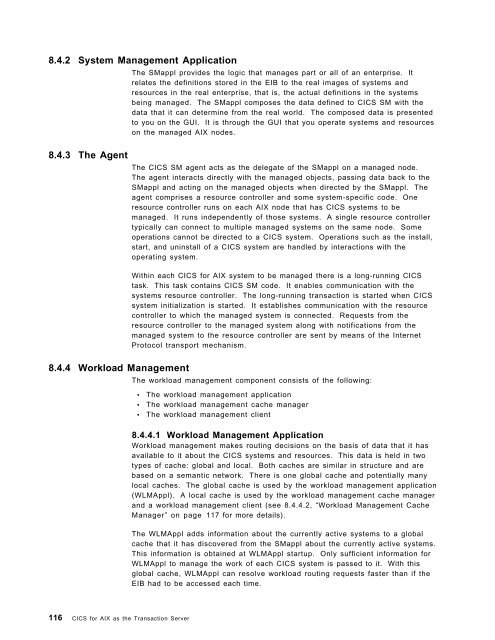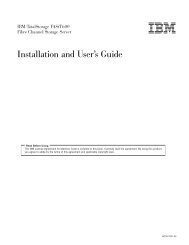Addressing OLTP Solutions with CICS: The Transaction Server ... - Ibm
Addressing OLTP Solutions with CICS: The Transaction Server ... - Ibm
Addressing OLTP Solutions with CICS: The Transaction Server ... - Ibm
Create successful ePaper yourself
Turn your PDF publications into a flip-book with our unique Google optimized e-Paper software.
8.4.2 System Management Application<br />
8.4.3 <strong>The</strong> Agent<br />
8.4.4 Workload Management<br />
116 <strong>CICS</strong> for AIX as the <strong>Transaction</strong> <strong>Server</strong><br />
<strong>The</strong> SMappl provides the logic that manages part or all of an enterprise. It<br />
relates the definitions stored in the EIB to the real images of systems and<br />
resources in the real enterprise, that is, the actual definitions in the systems<br />
being managed. <strong>The</strong> SMappl composes the data defined to <strong>CICS</strong> SM <strong>with</strong> the<br />
data that it can determine from the real world. <strong>The</strong> composed data is presented<br />
to you on the GUI. It is through the GUI that you operate systems and resources<br />
on the managed AIX nodes.<br />
<strong>The</strong> <strong>CICS</strong> SM agent acts as the delegate of the SMappl on a managed node.<br />
<strong>The</strong> agent interacts directly <strong>with</strong> the managed objects, passing data back to the<br />
SMappl and acting on the managed objects when directed by the SMappl. <strong>The</strong><br />
agent comprises a resource controller and some system-specific code. One<br />
resource controller runs on each AIX node that has <strong>CICS</strong> systems to be<br />
managed. It runs independently of those systems. A single resource controller<br />
typically can connect to multiple managed systems on the same node. Some<br />
operations cannot be directed to a <strong>CICS</strong> system. Operations such as the install,<br />
start, and uninstall of a <strong>CICS</strong> system are handled by interactions <strong>with</strong> the<br />
operating system.<br />
Within each <strong>CICS</strong> for AIX system to be managed there is a long-running <strong>CICS</strong><br />
task. This task contains <strong>CICS</strong> SM code. It enables communication <strong>with</strong> the<br />
systems resource controller. <strong>The</strong> long-running transaction is started when <strong>CICS</strong><br />
system initialization is started. It establishes communication <strong>with</strong> the resource<br />
controller to which the managed system is connected. Requests from the<br />
resource controller to the managed system along <strong>with</strong> notifications from the<br />
managed system to the resource controller are sent by means of the Internet<br />
Protocol transport mechanism.<br />
<strong>The</strong> workload management component consists of the following:<br />
• <strong>The</strong> workload management application<br />
• <strong>The</strong> workload management cache manager<br />
• <strong>The</strong> workload management client<br />
8.4.4.1 Workload Management Application<br />
Workload management makes routing decisions on the basis of data that it has<br />
available to it about the <strong>CICS</strong> systems and resources. This data is held in two<br />
types of cache: global and local. Both caches are similar in structure and are<br />
based on a semantic network. <strong>The</strong>re is one global cache and potentially many<br />
local caches. <strong>The</strong> global cache is used by the workload management application<br />
(WLMAppl). A local cache is used by the workload management cache manager<br />
and a workload management client (see 8.4.4.2, “Workload Management Cache<br />
Manager” on page 117 for more details).<br />
<strong>The</strong> WLMAppl adds information about the currently active systems to a global<br />
cache that it has discovered from the SMappl about the currently active systems.<br />
This information is obtained at WLMAppl startup. Only sufficient information for<br />
WLMAppl to manage the work of each <strong>CICS</strong> system is passed to it. With this<br />
global cache, WLMAppl can resolve workload routing requests faster than if the<br />
EIB had to be accessed each time.
















